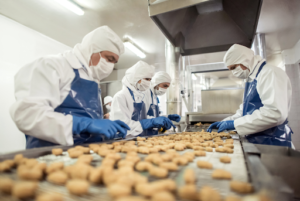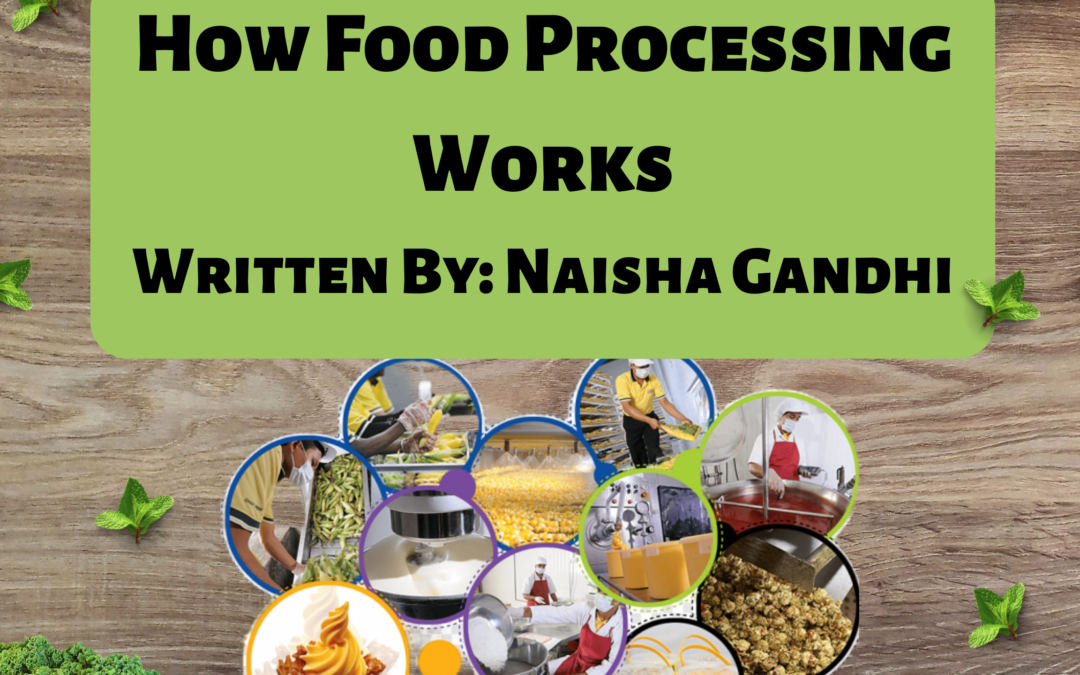Written by: Naisha Gandhi
Edited by: Fatima Khan
Designed by: Fatima Khan
Published by: Maryam Khan
What is Food Processing and How Does it Work?
Food processing is a procedure that turns any raw/fresh food into food products. Some common food processing methods may include washing, cutting, pasteurizing, freezing, fermenting, packaging, milling and dehydrating. Food processing also involves the addition of ingredients, such as preservatives or vitamins and minerals, to enhance the food’s nutritional value. Furthermore, basic food preparation, transforming a food product into a different form (such as making preserves from fruit), and preservation and packaging methods are all considered to be a part of food processing.
Types of Food Processing
There are 4 types of food processing. They include unprocessed/minimally processed foods, processed culinary ingredients, processed foods, and ultra-processed foods.
- Unprocessed/minimally processed foods: Foods that have had minimal processing have undergone minor modifications primarily for reasons of preservation, but these modifications do not significantly impact the food’s nutritional value.
- Processed culinary ingredients: Ingredients for food that have undergone minimum processing, such as pressing, grinding, or milling. Ex: oils from plants, seeds, nuts, etc.
- Processed foods: These foods often contain at least two or three ingredients and are prepared to be eaten right away.
- Ultra-processed foods: These foods are highly processed and contain many artificial ingredients to enhance flavor and texture.

What is the Purpose of Food Processing?
Before being consumed, nearly every food is processed in some way. Extending shelf life and removing microorganisms (which could cause sickness) are the two main commercial reasons for processing food. The act of merely cooking a dish or combining it with other ingredients to make a recipe is also regarded as food processing. Food processing is also very advantageous as it provides us with a range of convenient foods like packaged ready to eat meals, packaged salads, sliced and canned foods, and many more which can all be consumed on the go. Lastly, food processing can reduce the cost of several foods. It extends the food’s shelf life and reduces waste, bringing down the overall cost of food production.
Pros and Cons of Food Processing
Pros/benefits
- Ensures food safety
- more convenient
- Reduces food waste
- Preserves nutritional quality
- Increases availability
Cons/disadvantages:
- Many nutrients may be removed in this process
- Increase in sugar, sodium and fat
- Has many artificial ingredients
- May not be organic
CITATIONS
Food Processing | Eufic. (n.d.). The European Food Information Council. Retrieved June 25, 2023, from https://www.eufic.org/en/food-production/category/food-processing
Fox, N. (n.d.). The Many Health Risks of Processed Foods – LHSFNA. LHSFNA. Retrieved June 25, 2023, from https://www.lhsfna.org/the-many-health-risks-of-processed-foods/
Processed food: what is the purpose of food processing? (2017, March 20). The European Food Information Council. Retrieved June 25, 2023, from https://www.eufic.org/en/food-production/article/processed-food-qa
Food Processing and Health | The Nutrition Source | Harvard T.H. Chan School of Public Health. (n.d.). Harvard T.H. Chan School of Public Health. Retrieved June 25, 2023, from https://www.hsph.harvard.edu/nutritionsource/processed-foods/

